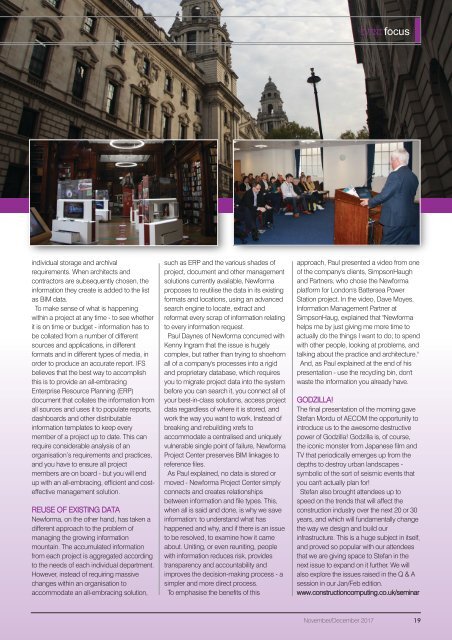Create successful ePaper yourself
Turn your PDF publications into a flip-book with our unique Google optimized e-Paper software.
EVENTfocus<br />
individual storage and archival<br />
requirements. When architects and<br />
contractors are subsequently chosen, the<br />
information they create is added to the list<br />
as BIM data.<br />
To make sense of what is happening<br />
within a project at any time - to see whether<br />
it is on time or budget - information has to<br />
be collated from a number of different<br />
sources and applications, in different<br />
formats and in different types of media, in<br />
order to produce an accurate report. IFS<br />
believes that the best way to accomplish<br />
this is to provide an all-embracing<br />
Enterprise Resource Planning (ERP)<br />
document that collates the information from<br />
all sources and uses it to populate reports,<br />
dashboards and other distributable<br />
information templates to keep every<br />
member of a project up to date. This can<br />
require considerable analysis of an<br />
organisation’s requirements and practices,<br />
and you have to ensure all project<br />
members are on board - but you will end<br />
up with an all-embracing, efficient and costeffective<br />
management solution.<br />
REUSE OF EXISTING DATA<br />
Newforma, on the other hand, has taken a<br />
different approach to the problem of<br />
managing the growing information<br />
mountain. The accumulated information<br />
from each project is aggregated according<br />
to the needs of each individual department.<br />
However, instead of requiring massive<br />
changes within an organisation to<br />
accommodate an all-embracing solution,<br />
such as ERP and the various shades of<br />
project, document and other management<br />
solutions currently available, Newforma<br />
proposes to reutilise the data in its existing<br />
formats and locations, using an advanced<br />
search engine to locate, extract and<br />
reformat every scrap of information relating<br />
to every information request.<br />
Paul Daynes of Newforma concurred with<br />
Kenny Ingram that the issue is hugely<br />
complex, but rather than trying to shoehorn<br />
all of a company's processes into a rigid<br />
and proprietary database, which requires<br />
you to migrate project data into the system<br />
before you can search it, you connect all of<br />
your best-in-class solutions, access project<br />
data regardless of where it is stored, and<br />
work the way you want to work. Instead of<br />
breaking and rebuilding xrefs to<br />
accommodate a centralised and uniquely<br />
vulnerable single point of failure, Newforma<br />
Project Center preserves BIM linkages to<br />
reference files.<br />
As Paul explained, no data is stored or<br />
moved - Newforma Project Center simply<br />
connects and creates relationships<br />
between information and file types. This,<br />
when all is said and done, is why we save<br />
information: to understand what has<br />
happened and why, and if there is an issue<br />
to be resolved, to examine how it came<br />
about. Uniting, or even reuniting, people<br />
with information reduces risk, provides<br />
transparency and accountability and<br />
improves the decision-making process - a<br />
simpler and more direct process.<br />
To emphasise the benefits of this<br />
approach, Paul presented a video from one<br />
of the company's clients, SimpsonHaugh<br />
and Partners, who chose the Newforma<br />
platform for London's Battersea Power<br />
Station project. In the video, Dave Moyes,<br />
Information Management Partner at<br />
SimpsonHaug, explained that "Newforma<br />
helps me by just giving me more time to<br />
actually do the things I want to do; to spend<br />
with other people, looking at problems, and<br />
talking about the practice and architecture."<br />
And, as Paul explained at the end of his<br />
presentation - use the recycling bin, don't<br />
waste the information you already have.<br />
GODZILLA!<br />
The final presentation of the morning gave<br />
Stefan Mordu of AECOM the opportunity to<br />
introduce us to the awesome destructive<br />
power of Godzilla! Godzilla is, of course,<br />
the iconic monster from Japanese film and<br />
TV that periodically emerges up from the<br />
depths to destroy urban landscapes -<br />
symbolic of the sort of seismic events that<br />
you can't actually plan for!<br />
Stefan also brought attendees up to<br />
speed on the trends that will affect the<br />
construction industry over the next 20 or 30<br />
years, and which will fundamentally change<br />
the way we design and build our<br />
infrastructure. This is a huge subject in itself,<br />
and proved so popular with our attendees<br />
that we are giving space to Stefan in the<br />
next issue to expand on it further. We will<br />
also explore the issues raised in the Q & A<br />
session in our Jan/Feb edition.<br />
www.constructioncomputing.co.uk/seminar<br />
November/December 2017 19

















